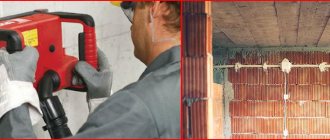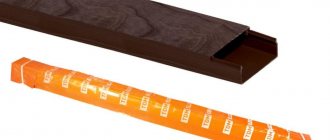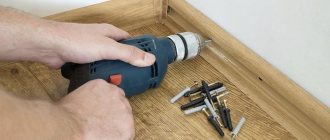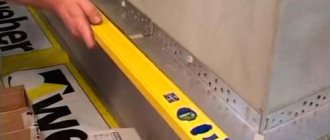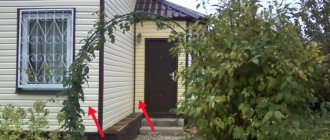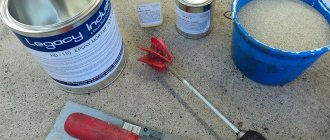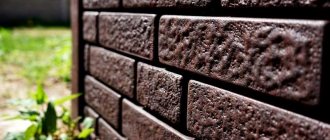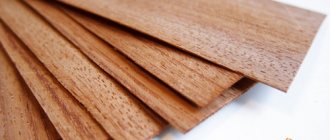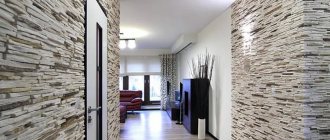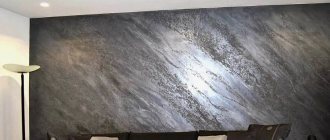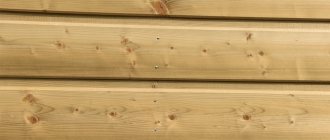Finishing walls with chipboard panels: features and installation technology
In the near future, chipboard sheets are often used for interior decoration of wall structures. They are successfully used both in living rooms and in office premises, shopping and entertainment centers, and gyms. Chipboard stands for chipboard. It also contains special adhesives made on a synthetic base. In some cases, additional components are used. In this article we will tell you about installing chipboard sheets on the wall.
Furniture corner
A fairly ordinary type of fastener. Easy to install. Does not require any additional holes in the panels for its installation. There are both iron and plastic options.
Quite a strong type of fastening. One of the shortcomings is that it is visible and does not look aesthetically pleasing. But this is the main type of fastening in integrated furniture.
Fastening chipboard sheets
This material can be installed using 4 different methods.
Lathing. The sheets are installed on the lathing, which is previously installed on the wall surface. This method is used in the case of uneven surfaces or when you need to leave some space between the chipboard sheets and the wall. The method is used to hide utility networks. The lathing is fixed to the wall using dowels, and chipboard sheets are installed on the frame using screws.
Fastening laminated chipboard to the wall (practice). (Securing particle board to wall)
READ Which putty is better to putty on walls?
Hardware. This method is used to install panels on a wooden or level base. For installation, a construction stapler, screws or nails are used.
Profile. This method is applicable for rooms with high humidity levels or with uneven wall structures. The duralumin profile is first attached to the wall, and chipboard sheets are already installed on it. Provided that laminated material is used, the resulting structure will be waterproof.
Glue. This method is easy and less time-consuming, but after installation it will not be possible to dismantle the slabs without damaging them. In addition, finishing walls with waterproof chipboard in this way requires a level base and the use of a special adhesive composition. The base requires priming and treatment with a disinfectant.
Methods for attaching chipboard sheets to walls
- Application of sheathing. A frequently used method involves installing wooden parts of the sheathing on the wall, secured with dowels. At the same time, chipboard panels are adapted to the sheathing itself using screws. The method is not bad in that it allows you not to smooth the walls and not create cleaning and degreasing of the surface. The only thing that is recommended to do is to treat the wood sheathing itself with an antiseptic before installation;
- Glue. wall finishing based on time and financial costs . But only if the walls are perfectly smooth and do not contain problem areas. Otherwise, it will be necessary to first clean the walls of previous coatings and dust, as well as degrease and prime them;
- Using a profile. Before fixing the panels, an aluminum profile consisting of horizontal and vertical components is mounted on the wall. The chipboard sheets themselves are already mounted in its grooves. In this case, the profile is attached to the wall using dowels, and the sheets are simply held on it, fixed by a metal structure. In this case, part of the profile is visible between the sheets, which can serve as an additional visual detail;
- Hardware method. Used when mounted on a wooden or perfectly flat base. During installation, you can use a construction stapler.
Confirmat
The most common type of fastener is confirmat. At the same time the easiest to use. With its help, assembling furniture is easier and faster than using other types of furniture screed. Especially if during assembly you have to drill holes for fasteners yourself. Using a confirmat, two parts are connected at an angle of 90 degrees.
In order to tighten the two parts, you need to drill two holes. One in one part, with a diameter equal to the diameter of the confirmator head, the other, at the end of the second part, with a smaller diameter equal to the diameter of the threaded part.
As a rule, drills with a diameter of 6 and 5 mm are used for this, respectively. However, there is a combination drill available for drilling holes at the same time. It is very comfortable. There is no need to constantly rearrange drill bits or use two drills at the same time.
Confirmat is a universal fastener, but it has some disadvantages and application features.
Confirmat should be used simultaneously with the use of dowels. A dowel is a wooden rod with a diameter of 6-8 mm and a length of 20-30 mm (in the photo below, next to the confirmation). The dowel acts as a guide and does not allow parts to move during tightening.
Despite the fact that furniture assembled using confiramate can be assembled or disassembled, furniture made from laminated chipboard does not tolerate this very well. As a rule, after one disassembly, the furniture screed no longer holds well.
The confirmation should be wrapped carefully. The best option is by hand or with a screwdriver at low speed. Otherwise, the confirmation thread turns into a drill, which breaks the hole.
In order to recess the head into the body of the furniture part, you should use a wrench and do it carefully, otherwise there is a possibility of the thread breaking. Sometimes it is necessary to pre-calculate.
Con fasteners. Those. Unlike other types of fasteners, it remains visible, so it is necessary to use special plugs or stickers to hide the fasteners.
How to attach laminated chipboard to the wall?
For the production of particle boards, small fragments of wood and synthetic resins are used: formaldehyde or phenol-formaldehyde compounds. The hot pressing method allows you to connect these components together and then form them into slabs of the required size. A laminated coating can be applied on top of the slab. Thanks to its presence, the slab is less subject to mechanical stress and acquires a presentable appearance by simulating the structure of wood.
If we compare sawdust boards with natural wood, they have a number of advantages. Uniformity of composition and uniform rigidity over the entire sheet area are some of them. Synthetic resins in the composition allow for the installation of fasteners. From a safety point of view, a material can be considered environmentally friendly if the product certificate indicates emission class E1.
- polyurethane;
- polyvinyl acetate (PVA)
- bitumen
Screw with drill, torx slot and countersunk head
Universal screws.
According to GOST standards 1144-80, 1145-80, 1146-80 are produced in diameters:
- 1.6 mm,
- 2.0 mm,
- 2.5 mm,
- 3.0 mm,
- 4.0 mm,
- 5.0 mm,
- 6.0 mm,
- 8.0 mm,
- 10.0 mm
And length:
- 13 mm,
- 16 mm,
- 20 mm,
- 25 mm,
- 30 mm,
- 35 mm,
- 40 mm,
- 45 mm,
- 50 mm,
- 60 mm,
- 70 mm,
- 80 mm,
- 90 mm,
- 100 mm,
- 110 mm,
- 120 mm.
The presence of a drill makes the screwing process much easier. It is recommended to drill a hole in the part to be fastened since the threads are incomplete. There are countersinking ribs on the inside of the head. Has the following dimensions:
- rod diameter 4-6 mm;
- length 18-160 mm;
- head diameter 7.5-11.5 mm;
- drill length 3.7-6.7 mm.
Screw with torx slot and half-round head
- rod diameter 3-6 mm;
- length 16-120 mm;
- head diameter 6-12 mm;
- head height 2.3-4.2 mm.
- The carving is complete. Pre-drilling is recommended, especially for end connections.
Self-tapping screw with torx slot and countersunk head
- rod diameter 3-6 mm;
- length 12-100 mm;
- head diameter 6-12 mm;
- head height 1.6-3.6 mm.
- Full thread.
Self-tapping screw with torx slot and semi-countersunk head
- rod diameter 3-5 mm;
- length 12-35 mm;
- head diameter 6-10 mm;
- head height 1.6-3 mm.
- A reinforced version made of higher strength steel is available.
Self-tapping screw with torx slot, wide semicircular head and partial thread
- rod diameter 4.8 mm;
- length 25-60 mm;
- head diameter 12 mm;
- head height 2.5 mm.
Self-tapping screw with torx slot, wide semicircular head and full thread
- rod diameter 6-7 mm;
- length 20-70 mm;
- head diameter 13-14 mm;
- head height 3 mm.
Self-tapping screw with cross slot Pz, full thread and semicircular head
- rod diameter 3-6 mm;
- length 16-200 mm;
- head diameter 6-12 mm;
- head height 2.3-4.2 mm.
Self-tapping screw with cross slot Pz, full thread and semi-countersunk head
- rod diameter 3-5 mm;
- length 12-100 mm;
- head diameter 6-10 mm;
- head height 1.6-3 mm.
Self-tapping screw with cross slot Pz, full thread and countersunk head
- rod diameter 3-6 mm;
- length 10-200 mm;
- head diameter 6-12 mm;
- head height 1.8-3.3 mm.
Phosphated screws
In everyday life they are also called “black screws”. Due to their low cost, they are actively used for rough finishing, for example, installing floors. Disadvantages include susceptibility to corrosion and fragility. It is not recommended to use under shear load. They have a countersunk head and a cross-shaped slot of the Ph type. Size range: rod diameter 3.5-4.8 mm; length 16-152 mm.
Confirmat
It is also known as a European screw or furniture tie – a relatively new fastening element. Equipped with a flat head with a hexagonal recess. Requires pre-drilling. May have the following dimensions: rod diameter from 5 to 7.5 mm; length from 40 to 70 mm.
For a more reliable and durable connection, it is recommended to first drill a hole for the threaded part, then a shallow one for the non-threaded part and make a countersink for the head. If you often have to use this type of fastener, then it makes sense to purchase a step drill that allows you to perform all these operations at the same time.
If you have the listed hardware, you will be able to mount any possible structures made of chipboard, be it boxes, furniture or finishing elements.
( 2 ratings, average 4.5 out of 5 )
Advantages and disadvantages of chipboard wall panels
Chipboards have gained popularity due to their positive quality characteristics:
- a huge selection of colors and textures;
- possibility of painting after installation;
- no special care products are required;
- installation is carried out in the shortest possible time without any special difficulties;
- reasonable prices, allowing a buyer with a small budget to choose the right material;
- withstands exposure to high temperatures and direct sunlight, exhibits resistance to mechanical stress and abrasion;
- have a presentable appearance (chipboard), which lasts for a long time.
READ DIY marble effect walls
Guides and racks made of timber can be reinforced with nails if the walls are wooden. Screws are used instead. When the walls are stone, dowels should be used. The racks are secured to the guides; the same screws or nails should be used. Everything will depend on the material of the main wall. The beads that will act as guides should be fixed at the top and bottom in increments of 1 m. There should be no less than three fasteners per bar.
Eccentric coupler
An eccentric coupler is often used in the factory production of furniture. The reason for this is the difficulty of drilling holes. An eccentric coupler consists of two parts: a pin and an eccentric. The pin is installed in one part, and the eccentric in another.
The main advantage of this type of fastener is that this fastener is hidden and therefore does not spoil the appearance of the furniture. In addition, this type of fastener, unlike confirmat, allows you to repeatedly assemble and disassemble furniture, which is important, for example, when moving. Also, using an eccentric coupler, you can connect parts at different angles.
What is a tongue and groove?
The word tongue comes from the German word Spund, that is, plug or plug.
Tongue and tongue is a special method of processing the edges of a slab, in which 2 edges are processed in the form of a groove, and the other 2 edges are processed in the form of a ridge that completely corresponds to the groove.
When assembling structural and finishing material, the ridge of one slab fits into the groove of another, due to which adjacent elements are fastened to each other.
The thickness of the ridge is 1/3 of the thickness of the finishing element, and the length is 6–15 mm, while the length of the ridge is equal to or 1 mm less than the depth of the groove.
So, take the tool you have chosen and cut off the hanging edges of the edge. They are cut close to the material. Then cut off the excess along the part. Melamine and thin plastic are easily cut with a knife. If the PVC edge is thicker - 0.5-0.6 mm or more, difficulties may arise. Such edges can be processed with a hand router, if you have one. This guarantees good results in a short time. The processing will take longer if you use sandpaper, but the result may not be worse.
Types, depending on the material to which it is attached
Modern manufacturers today use not only chipboard to make furniture. Glass, metal parts, and plastic elements are widely used. Fastenings for furniture made of chipboard were discussed throughout the material, and options for fastening objects made from other raw materials are discussed below:
- Glass - screw-type holders are used that are screwed into a wall made of concrete or plasterboard. They are used to fix shelves and mirror surfaces without damaging the coating of the part. For glass doors on the cabinet, the use of furniture hinges is suitable;
- Metal – screw fastenings are used to connect the shelves of metal racks. They are screwed into the racks using a drill or screwdriver. An attractive cap is installed on the front side;
- Plastic – plastic parts can be secured using any chipboard fasteners.
Separately, it is worth highlighting the dovetail fastening - it is used to connect drawers. The essence of the connection is to cut out a comb surface on each part, which is inserted into another part, resulting in end-to-end fixation. Choose only the type of fastening that suits you best. Before purchasing, be sure to calculate the thickness of the material so that during the assembly process screws and screws do not protrude on the surface.
Advantages and disadvantages of chipboard wall panels
Chipboards have gained popularity due to their positive quality characteristics:
- a huge selection of colors and textures;
- possibility of painting after installation;
- no special care products are required;
- installation is carried out in the shortest possible time without any special difficulties;
- reasonable prices, allowing a buyer with a small budget to choose the right material;
- withstands exposure to high temperatures and direct sunlight, exhibits resistance to mechanical stress and abrasion;
- have a presentable appearance (chipboard), which lasts for a long time.
Like any material, chipboard is not without its drawbacks:
- cannot withstand sudden changes in temperature conditions;
- exposure to moisture negatively affects the material, so it is not recommended to use it in rooms with high humidity;
- the ends need to be edged to hide the cut of the slab and protect it from moisture penetration;
- holes cannot be used several times;
- not strong enough for installation of heavy structures.
READ How to seal a bathtub from the wall
Varieties
The design and type of fastener will depend on the purpose of the furniture on which it is fixed. The elements can hold the product together inside, creating its frame, and also secure the base of the furniture to the wall or floor. Today the following types of fasteners are used:
- Furniture corner;
- Confirmation;
- Dowel;
- Screeds;
- Shelf supports;
- Bolt nut.
Each of these types has its own characteristics and features that distinguish them from each other. To find out which element is needed to assemble furniture, it is recommended to consider in detail the advantages and disadvantages of each category.
Furniture corner
This element belongs to a simple and outdated type of furniture fastener. It would seem that if a detail is outdated, then why talk about it? It's simple - such a corner will be useful for beginning assemblers. He will also become an assistant in the independent design of furniture products and subsequent assembly. In addition, its installation does not require any special equipment or skills. According to the production material, there are 2 types of furniture corners:
- Plastic - fastened with self-tapping screws, has a more miniature appearance and is relatively light weight. This corner is convenient to use for fastening light furniture panels or for supporting furniture parts;
- Metal - has stiffening ribs and is produced at an angle of 90 degrees. To fix the part, plastic or metal screws and couplings are used. There are holes on one side of the corner and grooves on the opposite side.
Such fasteners are used to connect the roof or bottom of a sliding wardrobe with its walls or when assembling cabinet kitchen furniture. Plastic options are equipped with a special plug, which gives the product a finished look. Metal ones are considered affordable and very durable. The disadvantages of fastening include the gradual loosening of surfaces secured with corners, as well as an unattractive appearance.
Confirmat
This name is usually used to refer to ordinary furniture screws. In another way they are called euroscrews, as well as euroscrews. The fastener is easy to install and does not require precision; a screwdriver or drill is required to fix it. In the screw head there is a hole for a hex key, which is also necessary for work.
To install this part, you need to drill two holes: one in the end of the part, and the other in the element that will be attached. The ease of assembling furniture using a confirmat allows the furniture maker to drill holes on site. It takes a minimum of time to complete the job. You can simplify the process as much as possible if you use a special drill for confirmation for installation. However, many furniture makers claim that over time this device becomes loose and the cutters become clogged with wood shavings. Therefore, for frequent use, standard drills are used.
The most popular and used confirmat size is 7x50 mm. Below are the pros and cons of using this fastener.
| Advantages | Flaws |
| Easy installation, no special equipment required. | The confirmation hat will be visible if it is not covered with a cap that matches the color of the furniture. |
| The fasteners provide excellent connection between the parts. | The fastener cuts threads in the chipboard material and can deform it. |
| Able to withstand increased loads. | Furniture fastened with a confirmat cannot be assembled and disassembled more than 3 times. |
| If desired, the part can be corrected using a mallet. |
Based on the information provided, it is worth noting that these furniture fastenings are convenient and reliable. But if you can use them, then it is better to give preference to an eccentric coupler.
Dowel
Hidden types of fastening are a feature of furniture assembled using dowels. This is a small wooden cylinder, its dimensions are often 35x8 mm. The first number shows the height of the element, and the second indicates the diameter of the fastener. The essence of fastening with dowels is as follows:
- Holes are drilled in each of the two parts;
- The holes must be coaxial - that is, coincide in the location of the axis;
- A dowel is inserted into one hole, which only goes halfway deep;
- A second piece of furniture is placed on the cant protruding from the furniture piece - this is how they are tied together.
In order for the connection to have increased strength, the hole is treated with PVA glue, which additionally fixes the dowels and makes them motionless. The big advantage of this type of furniture fastener is that it remains invisible: it cannot be seen from the outside or the inside. The dowel connection has some disadvantages: it is done once, so it is extremely difficult to disassemble such furniture without damage. The second disadvantage is that precise drilling of holes is required for a perfect fit of the two components. This nuance creates the need to use special devices.
Devices for installing dowels are called conductors. They can be factory-made or home-made. The former are considered the best in quality, but the latter can be made independently.
Ties
Today, there are two main types of furniture screeds - eccentric and intersectional. It is necessary to consider in more detail each of these types separately:
- Eccentric tie – this element is used only in conditions of factory assembly of furniture. To place it on a furniture panel, you need to use a device to drill an exact hole. The main advantage of such fasteners is the ability to remain invisible, then the furniture acquires a neat and attractive appearance. Another advantage, compared to confirmed ones, is that such furniture fasteners allow you to assemble and disassemble furniture several times without losing rigidity. In addition, using an eccentric coupler it is possible to fasten parts at an angle;
- Intersectional tie - represented by a screw and a nut, with the help of which two perpendicular furniture elements are tightened. An intersectional screed is convenient for fixing the headboard and bottom of the bed, as well as tabletops. It is necessary to select fasteners based on the thickness of the particle board.
Fastening laminated chipboard to the wall
Preparatory stage
Any installation method begins with a preparatory stage. The work involves cleaning the wall of all unnecessary things, eliminating finishing defects, leveling the surface, priming, and treating with special compounds. In particular, wooden surfaces are impregnated with fire retardants. Even before installation, possible shrinkage of the building is taken into account, so a gap is provided between the floor and ceiling. It is best to mark future fixation points so that all attachment points are on the same level. If you plan to install it with glue, then the sheet is processed until rough on the reverse side with sandpaper.
Useful tips
In order for the chipboard wall cladding to be of high quality, it is recommended to take into account some points:
- All material must be from the same batch. Products are checked for damage and swelling. It is better if the surface is covered with a protective film, which should be removed only before installation.
The quality of the coating of chipboard wall panels must be carefully checked before purchasing - The products must be kept indoors for 24 hours. This will allow her to acclimatize.
- If you need to cover the surface with panels without tongue and groove, the components will provide a more attractive appearance.
- In order to correctly attach the slabs to the screws, it is recommended to carry out preliminary markings; all fixation points should be located at the same level.
When installing panels on confirmants, the caps are covered with plastic plugs
When choosing thick panels, it is necessary to better prepare the base for them, since they have significant weight.
Fastening chipboard sheets to walls
To attach the panels to the surface, you need to use one of four possible methods:
- Using a wooden frame, you can level the walls and also hide utility networks. It is recommended to pre-treat the sheathing with special compounds to extend its service life. Using dowels, the frame is fixed to the surface, after which the panels are attached using self-tapping screws.
- Aluminum profiles allow the installation of laminated particle boards in rooms with high humidity. Installing the slabs is not difficult. First, the profiles are installed on the wall, and then the sheets are fixed on them.
- When the base is flat or wooden, staples are excellent as fasteners. Installation is carried out using a special construction stapler.
- If the adhesive method is used, you must first prime the walls and treat them with antiseptic agents. The surface must be flat. A distinctive feature of installation is speed and ease. But it will not be possible to dismantle the sheets without damage.
Installation can be done directly on the wall or on a wooden frame. In the latter case, it becomes possible to lay a thermal insulation layer. If connecting profiles are used, they can be unpainted or painted in the color of the panel or in a contrasting color.
Chipboard installation
When installing on the sheathing, you should first decide on the material. When walls are severely curved, it is recommended to use metal studs. Installation must be carried out strictly according to level. Wooden beams are attached directly to the wall, although hangers can also be used. The cladding is carried out using the tongue-and-groove system, followed by fixation with self-tapping screws or using profiles.
Large format products can be conveniently mounted using aluminum profiles. The work begins with the installation of fasteners. If the sheets will be placed vertically, then the corner is placed first. The horizontal position involves installing a starting bar. The sheets are connected using a connecting strip. If necessary, dismantling is carried out without damaging the surface of the sheets.
Working with glue is simple: just apply it dotwise or in lines on the rough side of the panel, apply it to the required place, and press down. This type of fixation is convenient in small areas and can reliably attach materials to each other. Installation with a stapler is also easy. The main thing is to adjust it so that the brackets do not bend during installation. To do this, you will need to select the appropriate staple length and impact force.
Sources:
https://laspro.ru/montazh-obychnoj-dsp-na-stenu/ https://slavasozidatelyam.ru/strojka-i-remont/kreplenie-ldsp-k-stene/
Selecting fasteners for working with chipboard
There are several methods using which you can install chipboard panels to the wall. Depending on which one is chosen, the fittings are selected. It could be:
- special glue;
- aluminum profiles – end, connecting, corner;
- self-tapping screws;
- dowels;
- staples;
- nails.
